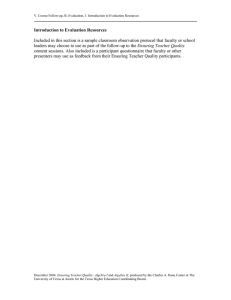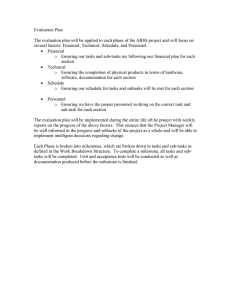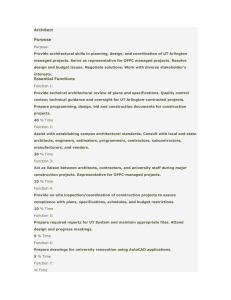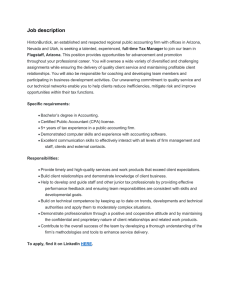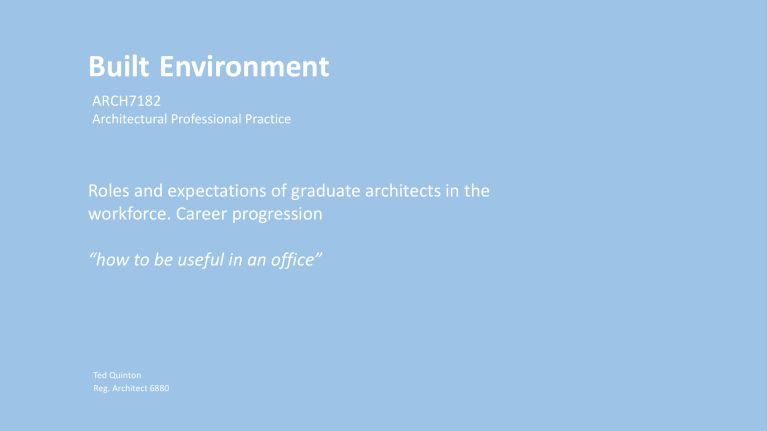
Built Environment ARCH7182 Architectural Professional Practice Roles and expectations of graduate architects in the workforce. Career progression “how to be useful in an office” Ted Quinton Reg. Architect 6880 What are the roles of a graduate architect? Typically on a large learning curve. Uni v workplace, the two don’t always equate Tasks are aimed at providing assistance to a project architect or team and at all levels and practice sizes is related to tasks that do not require advanced knowledge of architectural process. However at any level will require a fast integration into office culture Many times working on small projects is a way of integrating into a practice Working on competitions, model making, presentations and the like is a very useful way to begin What are the main expectations of graduates? • Having a great attitude • Being punctual • Being reliable • Ability to work in teams • Having initiative • Making contributions • Keen to grow and learn quickly • Keen to use their skills in the most effective way possible • Be forthcoming without getting in the way • Knowing they will ask questions and not sit in the corner silently. 5 minute rule! • Willingness to hear feedback • Speaking up if something is not right What are the main expectations of your employer? • Ensuring clear and defined roles • Ensuring that tasks are not beyond your skill level • Ensuring you are not put in compromising or difficult situations • Ensuring there is sufficient training and support for new programs • Ensuring there is a good integration into the office culture • Ensuring that you know who is the person to talk to if there are issues • Ensuring a good physical environment/safety • Maintaining good communication and feedback with agreed dates for reviews What are the most useful attributes to have? Initiative If there is nothing to do find something to do……! • • • • • • • • • • • • • Familiarise yourself with the reference and product libraries Read the office Quality Assurance protocols Understand the CAD software comprehensively Understand the project organisation protocols Understand the roles of people in the office Remember names! Be useful Be forthcoming with ideas and insights. Ask to sit in on meeting if appropriate/take minutes Ask to help don’t wait to be asked Do not be afraid of menial tasks, photocopying is learning! Volunteer for something Don’t be scared of doing the dishes! Awareness • be cognisant of what and who is around you. (spatial awareness is paramount to architecture!) • Know where things are and how to find them, ie codes and standards, office literature etc. • Know what projects people are working on and what stage they are at • Don’t be blinkered, ie if it isn’t mine I don’t have to worry about it • If something is out of place say something Knowledge • Understand common architectural terminology, ie DA, CC, DCP, LEP, SEPP, BCA, AS, • Understand the main aspects of the various stages of projects, ie DA, CC, tender etc • If you are good at something use that in the most productive and efficient way and make people know about it • Keep up to date with architectural events, projects both national and international. • Showing a good knowledge of architectural literacy instils confidence EARLY CAREER PROGRESSION Different practice modalities and opportunities Small practice • dealing directly with the practice owner(s), lots of variety and need to be versatile. Requires a lot of initiative and self direction. • Generally learning curve is massive with immersion in many different aspects. • Need to be very willing to take on responsibility and act on it. • Can end up working and looking after many aspects of a project from a very early stage. • Projects tend to be of smaller scale, residential or small public buildings. • Small practice generally has a high level of reliance upon each person and your role will be integral from a very early stage. • Good opportunity to lead projects within a very short time and start to fulfil the AACA requirements/logbook • Everyone knows everyone in the office and usually close camaraderie and social engagement on a daily basis. • Small practice is a like a family! Medium practice • working in a small team and part of a larger office environment. • Relatively regular interaction with the principle(s) • Need to be able to work to clear deadlines and specific tasks that are set. • Role will be more clearly defined and project specific • Good scope to show level of skill in production of drawings, organisational aspects, working in a team • Progression to a project assistant level with increased responsibilities across more complex aspects of projects • Would be working more independently and responsible for milestones • Would generally be moved across project teams • Generally good level of interaction with opportunities to socialise across and with various members of the practice. Large practice • working in larger teams • Have opportunity to work on urban scale projects or specific sector projects like education, commercial etc. • Relatively little interaction with the principle(s)more with project leads/associates • Need to be able to work to clear deadlines and specific tasks that are set. • Role will be more clearly defined and project specific • Good scope to show level of skill in production of drawings, organisational aspects, working in a team • Progression to a project assistant level with increased responsibilities across more complex aspects of projects • Ask to be moved around teams for exposure to different project types • Interaction around team project groups with opportunities to socialise across the practice. Ability to be involved in different activities and professional or social events CONCLUSION • INITIATIVE, AWARENESS, KNOWLEDGE • BE VERSATILE, EXPAND YOUR SKILL SET • HAVE HUMILITY BUT SHARE YOUR KNOWLEDGE AND DON’T BE AFRAID TO SPEAK OUT • TRY DIFFERENT PRACTICE MODALITIES TO SEE WHAT WORKS BEST FOR YOU • CROSS SECTION OF EXPERIENCES

